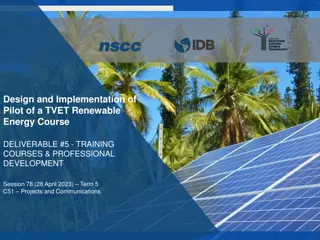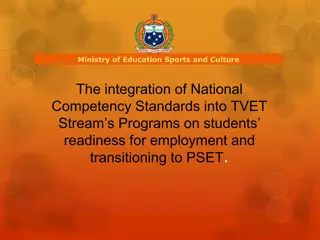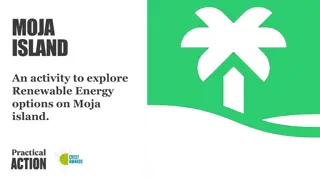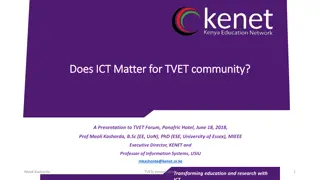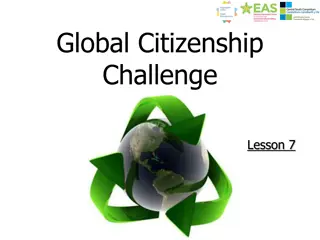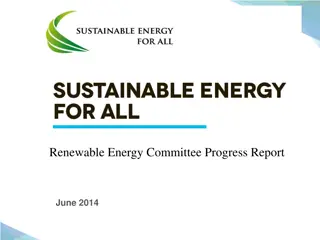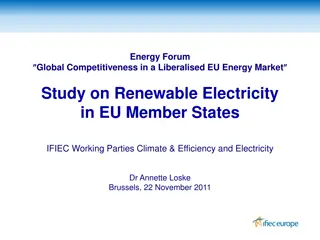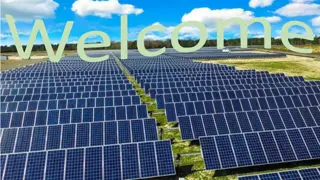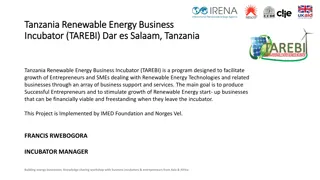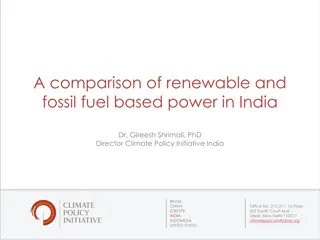TVET Renewable Energy Course: Advanced Energy System Design
"Explore the in-depth curriculum of Course 62 - Advanced Energy System Design in the TVET Renewable Energy program. This course delves into practical applications, skills development, and industry qualifications, preparing students for success in the renewable energy sector. Discover how theory transforms into hands-on experience, leading to competent and adaptable professionals desired by employers in the evolving Green Economy of Belize."
Download Presentation

Please find below an Image/Link to download the presentation.
The content on the website is provided AS IS for your information and personal use only. It may not be sold, licensed, or shared on other websites without obtaining consent from the author. Download presentation by click this link. If you encounter any issues during the download, it is possible that the publisher has removed the file from their server.
E N D
Presentation Transcript
Design and Implementation of TVET Renewable Energy Course Pilot DELIVERABLE #5 - TRAINING COURSES & PROFESSIONAL DEVELOPMENT Session (June 23, 2023) Term 4 C 62 Advanced Energy System Design
Course 62 Advanced Energy System Design Year Two April to June Term 6 10 Weeks with: 58.7 Classroom hours 10 weeks x 9 periods/week Three periods Tuesday AM Two periods Tuesday PM One period lab Wednesday PM X 2 Three periods Thursday AM 2
Marking Breakdown Individual Tests 20% Individual Assignments 30% Group Projects 40% Employability Skills 10% 3
What does success look like for students? Students completing Year 1 (Installer) or Year 2 (Designer) Renewable Energy (RE) and Energy Efficiency (EE) program requirements Students are Industry Qualified under NABCEP and others Instructors are achieving the desired course outcomes and student understanding with the required resources ITVET is equipped with resources for a scalable and sustainable program Skills are competently applied to a changing Green Economy Belize Employers are hiring competent and adaptable team members from the program 4
Development of Course 62 From Theory to Practical Application through: Development of hands-on experiments and assessments of energy systems in Belize to act as a basis for assignments and projects within C-62 Advanced Energy System Design tasks and outcomes. 5
What does success look like for employers? Advanced Energy System Design Practice: Identification of the opportunity for advanced energy system design in client buildings or processes Analysis of loads and identification of advanced energy system components to reduce energy consumption Communication with clients to promote energy efficiency through advanced energy system design recommendations 6
Course Connections: C62 Advanced Energy System Design course completion is delivered in Term six with: C61 Business Operations and Entrepreneurship C63 Final Project 7
Master Plan and TDAP Use Typical of ITVET: For all courses By all Instructors For each term Training Delivery and Assessment Plan Profile of the Trainer / Portfolio of the Trainee Program Policies & Regulations / Technology Requirements Instructional Methods / Modes (Face to Face and Online) Resources (Technical Underpinning Knowledge and Skills) Delivery Schedule by week and Instructional Methods (IM) Practical Grading Criteria and Theoretical Grading Criteria 9
Master Plan Learning Outcomes Master Plan Learning Outcome 1 Knowledge-Base Through reading, listening and understanding classroom lectures, students will gain knowledge that will enable the application of their skills within the class, lab, and industry. Master Plan Learning Outcome 2 Investigation An ability to conduct investigations of a complex problem by methods that include appropriate experiments, analysis and interpretation of data, and synthesis of information in order to reach valid conclusions. 10
Master Plan Learning Outcomes Master Plan Learning Outcome 3 Design An ability to design solutions for complex, open-ended engineering problems and to design systems, components or processes that meet specified needs with appropriate attention to health and safety risks, applicable standards, and economic, environmental, cultural and societal considerations. An ability to assess the requirements of an energy system by collecting data and making conclusions much like a detective solving a case. Your case is how to create the most advanced energy system. You will identify the best building envelope properties, system properties, and loads to recommend an advanced system that will meet the demand without curtailment! 11
Master Plan Learning Outcomes Master Plan Learning Outcome 4 Use of technical tools An ability to create, select, apply, adapt, and extend appropriate techniques, resources, and modern technical tools to a range of renewable energy activities, from simple to complex, with an understanding of the associated limitations. Master Plan Learning Outcome 5 Individual work and teamwork An ability to work effectively as a member and leader in teams, preferably in a multi-disciplinary setting. 12
Master Plan Learning Outcomes Master Plan Learning Outcome 6 Communication skills An ability to communicate complex renewable energy concepts within the technical community, and with society at large. An ability to read, write, speak and listen, and comprehend information. An ability to write effective reports and design documentation An ability to effectively give and respond to clear instructions. Master Plan Learning Outcome 7 Professionalism An understanding of the roles and responsibilities of a renewable energy practitioner in society, especially the protection of the public and the public interest. 13
Master Plan Learning Outcomes Master Plan Learning Outcome 8 Impact of renewable energy on society and the environment: An ability to analyze social and environmental aspects of renewable energy activities. An understanding of the interactions that renewable energy projects have with the economic, social, health, safety, legal, and cultural aspects of society. A prediction of the concepts of sustainable design, development and environmental stewardship. 14
Master Plan Tasks Task 01: Identify energy systems in the built environment Task 02: Identify design concepts and components to implement an advanced energy system in a building or process Task 03: Identify relevant codes and requirements that impact advanced energy system design and installation Task 04: Identify factors that influence advanced energy system design and performance Task 05: Identify equipment specification data Task 06: Explain energy storage and advanced energy system sizing considerations 15
Task 3 Task 03: Identify relevant codes and requirements that impact advanced energy system design and installation. International Organization for Standardization (ISO) Is an independent, non-governmental international organization with a membership of 168 national standards bodies. 16 https://www.iso.org/about-us.html
Task 3 17 https://www.iso.org/about-us.html
Task 3 Identify relevant codes and requirements that impact advanced energy system design and installation. International Organization for Standardization (ISO) Is an independent, non-governmental international organization with a membership of 168 national standards bodies. 18 https://www.iso.org/about-us.html
Task 3 National Standards Bodies: Belize Bureau of Standards (BZBS) Belize Subscriber Membership *Subscriber members keep up to date on ISO's work but cannot participate in it, nor can they sell or adopt ISO International Standards nationally Established in 1992, The Belize Bureau of Standards is a government department charged with the responsibility for standards, metrology and conformity assessment. *Metrology is the scientific study of measurement 19 https://www.iso.org/member/5504525.html
Task 3 20 2021. BELIZE Ministry of Energy & Public Utilities Sustainable Energy Roadmap 2021-2040
Task 3 21 2021. BELIZE Ministry of Energy & Public Utilities Sustainable Energy Roadmap 2021-2040
Task 3 International Organization for Standardization (ISO) 9060:2018 Related to Solar Energy Outlines the specification and classification of instruments for measuring hemispherical solar and direct solar radiation such as pyranometers and pyrheliometers. 22 https://www.iso.org/standard/67464.html
Task 3 A pyranometer is a sensor that converts the global solar radiation it receives into an electrical signal that can be measured. Pyranometers measure a portion of the solar spectrum. As an example, the CMP21 pyranometer measures wavelengths from 0.285 to 2.8 m, and measures radiant flux in W/m2. m is the symbol for micrometer, a System International (SI) unit of length equal to 10^-6 meters or 1 millionth of a meter. Tiny! 23 www.hukseflux.com
Task 3 A pyrheliometer is a device that measures solar irradiance coming directly from the sun. The SI units of irradiance are watts per square metre (W/m ). Pyrheliometershave been historically used for climate data, but in recent years it is used to measure irradiance related to solar generation systems. Why would these tools be used to measure global solar radiation and solar irradiance in an AES? 24 www.hukseflux.com
Task 3 Excellent instructional 34-minute video: How to measure solar radiation 25 www.hukseflux.com
Task 3 The Advanced Energy Design Guides (AEDGs) series from The United States Office of Energy Efficiency and Renewable Energy (EERE) provides design guidance for buildings that use 50% less energy than those built to the requirements of the American National Standards Institute (ANSI)/American Society of Heating Refrigeration and Airconditioning Engineers (ASHRAE)/Illuminating Engineering Society (IES) Standard 90.1- 2004 commercial code and are specific to prominent building types across each of the eight U.S. climate zones. 26 https://www.ashrae.org/technical-resources/aedgs
Task 3 27 https://www.ashrae.org/technical-resources/aedgs
Task 3 28 https://www.ashrae.org/technical-resources/aedgs
Task 3 29
Task 3 30 K ppen climate classification. (2023, June 13). In Wikipedia. https://en.wikipedia.org/wiki/K%C3%B6ppen_climate_classification
Task 3 International Green Construction Code (IgCC) The 2018International Green Construction Code is an adoptable, usable and enforceable standard for green building design and construction. As a co-sponsor, USGBC encourages the widespread adoption of the 2018-IgCC. Within jurisdictions that adopt the new green code, USGBC will allow projects pursuing LEED certification to be recognized for their compliance to select IgCC measures. Learn more about 2018-IgCC 31 2021.IgCCcodes.iccsafe.org
Task 3 International Green Construction Code (IgCC) The 2018International Green Construction Code is an adoptable, usable and enforceable standard for green building design and construction. As a co-sponsor, USGBC encourages the widespread adoption of the 2018-IgCC. Within jurisdictions that adopt the new green code, USGBC will allow projects pursuing LEED certification to be recognized for their compliance to select IgCC measures. Learn more about 2018-IgCC 32 2021.IgCCcodes.iccsafe.org
Task 3 International Green Construction Code (IgCC) Buildings account for over 12% of water use, 40% of CO2 emissions, 65% of all waste outputs, and more than 70% of electricity consumption. The organizations believe green buildings offer solutions to many of these problems by conserving resources, regenerating sites, and providing economic and societal benefits. Advanced Energy System design can achieve all of these goals! 33 2021.IgCCcodes.iccsafe.org
Task 3 International Green Construction Code (IgCC) Buildings account for over 12% of water use, 40% of CO2 emissions, 65% of all waste outputs, and more than 70% of electricity consumption. Our organizations believe green buildings offer solutions to many of these problems by conserving resources, regenerating sites, and providing economic and societal benefits. 34 2021.IgCCcodes.iccsafe.org
Task 3 Transport-related emission reduction may not happen uniformly across global regions. Developed Countries, Eastern Europe and West Central Asia countries project a decrease from 2020 levels by 2050 across all scenarios Projection is a decrease which will limit global warming to 1.5 C by 2100 Emissions may increase in Africa, Asia and Pacific (APC), Latin America, the Caribbean, and the Middle East in some of these scenarios. {10.7} Grubb.M, et al.(2022). AR6 WGIII Climate Change 2022 Mitigation of Climate Change TechnicalSummary 35
Belize Consolidated Project Plan Bunker, Kaitlyn, Roy Torbert, et al., Belize Consolidated Project Plan. Rocky Mountain Institute, 2018, http:// www.rmi.org/Belize- consolidated-project-plan 36
UNSDGs The United Nations Sustainable Development Goals (UNSDGs) 17 (SDGs) are an urgent call for action by all countries - developed and developing - in a global partnership. Are focused on ending poverty and other deprivation Must go hand-in-hand with strategies that improve health and education, reduce inequality, and spur economic growth all while tackling climate change and working to preserve our oceans and forests. 2022.UNSDG Goals. https://sdgs.un.org/goals 37
UNSDGs Goal 11: Sustainable Cities and Communities Make cities and human settlements inclusive, safe, resilient and sustainable Johannesburg Plan of Implementation (JPOI). JPOI provided multiple anchor points for sustainable transport, in the context of infrastructure, public transport systems, goods delivery networks, affordability, efficiency and convenience of transportation, as well as improving urban air quality and health and reducing greenhouse gas emissions. 2022.UNSDGhttps://sdgs.un.org/topics/sustainable-transport. 38
Bi-directional Charging Systems Watch: NSPI Coritech Bidirectional Car Charger NSCC 39
Design Software Leadership in Environmental Engineering Design (LEED) Buildings consume energy and resources at an alarming rate. We can do better. LEED provides a framework for healthy, efficient, carbon and cost-saving green buildings. LEED certification is a globally recognized symbol of sustainability achievement, and it is backed by an entire industry of committed organizations and individuals paving the way for market transformation! 40



















